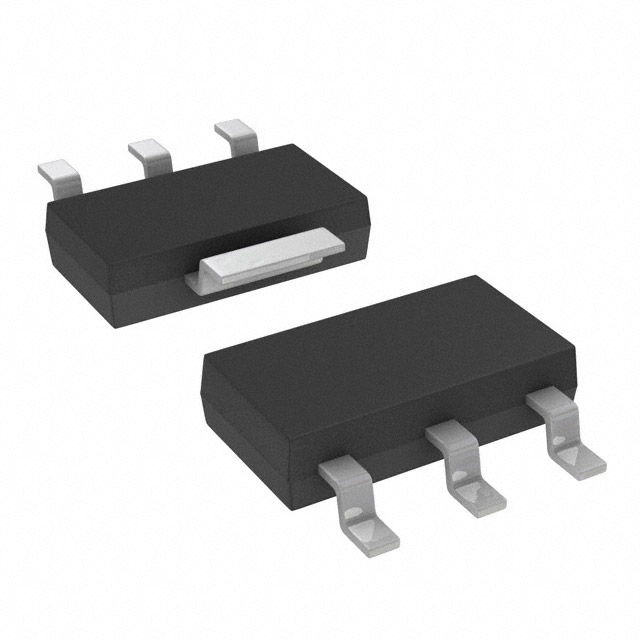PZT2222A: Transistor Encyclopedia Entry
Introduction
The PZT2222A is a type of transistor that belongs to the category of bipolar junction transistors (BJTs). This entry provides an overview of the basic information, specifications, pin configuration, functional features, advantages and disadvantages, working principles, application field plans, and alternative models of the PZT2222A transistor.
Basic Information Overview
- Category: Bipolar Junction Transistor (BJT)
- Use: The PZT2222A transistor is commonly used for amplification and switching applications in electronic circuits.
- Characteristics: It exhibits high current gain, low noise, and low power dissipation.
- Package: The transistor is typically available in a TO-92 package.
- Essence: It is a general-purpose NPN transistor suitable for various low-power applications.
- Packaging/Quantity: The PZT2222A is often sold in reels or tubes containing multiple units.
Specifications
The key specifications of the PZT2222A transistor include: - Maximum Collector-Base Voltage (Vcbo): 75V - Maximum Collector-Emitter Voltage (Vceo): 40V - Maximum Emitter-Base Voltage (Vebo): 6V - Continuous Collector Current (Ic): 600mA - Power Dissipation (Pd): 625mW - Transition Frequency (ft): 250MHz - Operating Temperature Range: -55°C to 150°C
Detailed Pin Configuration
The PZT2222A transistor has three pins: 1. Emitter (E): Connected to the N-type material and is the source of electrons. 2. Base (B): Controls the flow of current between the collector and emitter. 3. Collector (C): Attracts the majority charge carriers from the base.
Functional Features
The PZT2222A transistor offers the following functional features: - High current gain (hFE) of typically 100 to 300 at Ic = 0.1mA. - Low noise and low power dissipation characteristics. - Fast switching speed suitable for digital and analog applications.
Advantages and Disadvantages
Advantages
- Versatile and widely used in various electronic circuits.
- High current gain allows for efficient signal amplification.
- Low noise performance makes it suitable for sensitive applications.
Disadvantages
- Limited maximum collector current compared to power transistors.
- Moderate power dissipation capability restricts its use in high-power applications.
Working Principles
The PZT2222A operates based on the principles of bipolar junction transistors. When a small current flows into the base terminal, it controls a much larger current between the collector and emitter terminals, enabling amplification and switching functions.
Detailed Application Field Plans
The PZT2222A transistor finds extensive use in the following application fields: - Audio amplifiers and preamplifiers - Signal processing circuits - Switching circuits in electronic devices - Oscillator and frequency multiplier circuits - Sensor interface circuits
Detailed and Complete Alternative Models
Some alternative models to the PZT2222A transistor include: - 2N2222A - BC547 - BC548 - 2N3904 - 2N4401
In conclusion, the PZT2222A transistor is a versatile component with wide-ranging applications in electronic circuits, offering a balance of performance and efficiency within its specified operating parameters.
Word Count: 496 words
قم بإدراج 10 أسئلة وإجابات شائعة تتعلق بتطبيق PZT2222A في الحلول التقنية
What is PZT2222A?
- PZT2222A is a general-purpose NPN bipolar junction transistor (BJT) commonly used in electronic circuits for amplification and switching applications.
What are the key specifications of PZT2222A?
- The PZT2222A has a maximum collector current of 600mA, a maximum collector-base voltage of 40V, and a maximum power dissipation of 500mW.
How can PZT2222A be used in amplification circuits?
- PZT2222A can be used as a common-emitter amplifier to amplify small signals in electronic circuits.
In what types of switching applications is PZT2222A commonly used?
- PZT2222A is often used in low-power switching applications such as driving small relays, LEDs, or other low-current loads.
What are the typical operating conditions for PZT2222A?
- The typical operating temperature range for PZT2222A is -55°C to +150°C, making it suitable for a wide range of environments.
Can PZT2222A be used in high-frequency applications?
- While PZT2222A can be used in moderate frequency applications, it may not be suitable for very high-frequency applications due to its transition frequency and capacitance characteristics.
What are some common alternatives to PZT2222A?
- Common alternatives to PZT2222A include 2N2222, PN2222, and BC547, which are similar NPN transistors with comparable characteristics.
How should PZT2222A be handled to prevent damage?
- PZT2222A should be handled with proper electrostatic discharge (ESD) precautions to avoid damage to the sensitive semiconductor components.
Are there any specific layout considerations when using PZT2222A in a circuit?
- It's important to minimize lead lengths and keep the collector, base, and emitter connections as short and direct as possible to reduce parasitic effects and improve performance.
Where can I find detailed application notes for using PZT2222A in technical solutions?
- Detailed application notes for PZT2222A can be found in the manufacturer's datasheet, as well as in various electronics engineering resources and forums online.


